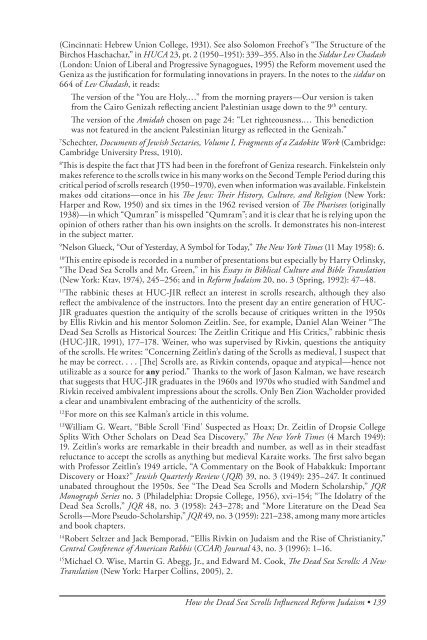The American Jewish Archives Journal, Volume LXI 2009, Number 1
The American Jewish Archives Journal, Volume LXI 2009, Number 1
The American Jewish Archives Journal, Volume LXI 2009, Number 1
You also want an ePaper? Increase the reach of your titles
YUMPU automatically turns print PDFs into web optimized ePapers that Google loves.
(Cincinnati: Hebrew Union College, 1931). See also Solomon Freehof’s “<strong>The</strong> Structure of the<br />
Birchos Haschachar,” in HUCA 23, pt. 2 (1950–1951): 339–355. Also in the Siddur Lev Chadash<br />
(London: Union of Liberal and Progressive Synagogues, 1995) the Reform movement used the<br />
Geniza as the justification for formulating innovations in prayers. In the notes to the siddur on<br />
664 of Lev Chadash, it reads:<br />
<strong>The</strong> version of the “You are Holy.…” from the morning prayers—Our version is taken<br />
from the Cairo Genizah reflecting ancient Palestinian usage down to the 9 th century.<br />
<strong>The</strong> version of the Amidah chosen on page 24: “Let righteousness.… This benediction<br />
was not featured in the ancient Palestinian liturgy as reflected in the Genizah.”<br />
7 Schechter, Documents of <strong>Jewish</strong> Sectaries, <strong>Volume</strong> I, Fragments of a Zadokite Work (Cambridge:<br />
Cambridge University Press, 1910).<br />
8 This is despite the fact that JTS had been in the forefront of Geniza research. Finkelstein only<br />
makes reference to the scrolls twice in his many works on the Second Temple Period during this<br />
critical period of scrolls research (1950–1970), even when information was available. Finkelstein<br />
makes odd citations—once in his <strong>The</strong> Jews: <strong>The</strong>ir History, Culture, and Religion (New York:<br />
Harper and Row, 1950) and six times in the 1962 revised version of <strong>The</strong> Pharisees (originally<br />
1938)—in which “Qumran” is misspelled “Qumram”; and it is clear that he is relying upon the<br />
opinion of others rather than his own insights on the scrolls. It demonstrates his non-interest<br />
in the subject matter.<br />
9 Nelson Glueck, “Out of Yesterday, A Symbol for Today,” <strong>The</strong> New York Times (11 May 1958): 6.<br />
10 This entire episode is recorded in a number of presentations but especially by Harry Orlinsky,<br />
“<strong>The</strong> Dead Sea Scrolls and Mr. Green,” in his Essays in Biblical Culture and Bible Translation<br />
(New York: Ktav, 1974), 245–256; and in Reform Judaism 20, no. 3 (Spring, 1992): 47–48.<br />
11 <strong>The</strong> rabbinic theses at HUC-JIR reflect an interest in scrolls research, although they also<br />
reflect the ambivalence of the instructors. Into the present day an entire generation of HUC-<br />
JIR graduates question the antiquity of the scrolls because of critiques written in the 1950s<br />
by Ellis Rivkin and his mentor Solomon Zeitlin. See, for example, Daniel Alan Weiner “<strong>The</strong><br />
Dead Sea Scrolls as Historical Sources: <strong>The</strong> Zeitlin Critique and His Critics,” rabbinic thesis<br />
(HUC-JIR, 1991), 177–178. Weiner, who was supervised by Rivkin, questions the antiquity<br />
of the scrolls. He writes: “Concerning Zeitlin’s dating of the Scrolls as medieval, I suspect that<br />
he may be correct. . . . [<strong>The</strong>] Scrolls are, as Rivkin contends, opaque and atypical—hence not<br />
utilizable as a source for any period.” Thanks to the work of Jason Kalman, we have research<br />
that suggests that HUC-JIR graduates in the 1960s and 1970s who studied with Sandmel and<br />
Rivkin received ambivalent impressions about the scrolls. Only Ben Zion Wacholder provided<br />
a clear and unambivalent embracing of the authenticity of the scrolls.<br />
12 For more on this see Kalman’s article in this volume.<br />
13 William G. Weart, “Bible Scroll ‘Find’ Suspected as Hoax; Dr. Zeitlin of Dropsie College<br />
Splits With Other Scholars on Dead Sea Discovery,” <strong>The</strong> New York Times (4 March 1949):<br />
19. Zeitlin’s works are remarkable in their breadth and number, as well as in their steadfast<br />
reluctance to accept the scrolls as anything but medieval Karaite works. <strong>The</strong> first salvo began<br />
with Professor Zeitlin’s 1949 article, “A Commentary on the Book of Habakkuk: Important<br />
Discovery or Hoax?” <strong>Jewish</strong> Quarterly Review (JQR) 39, no. 3 (1949): 235–247. It continued<br />
unabated throughout the 1950s. See “<strong>The</strong> Dead Sea Scrolls and Modern Scholarship,” JQR<br />
Monograph Series no. 3 (Philadelphia: Dropsie College, 1956), xvi–154; “<strong>The</strong> Idolatry of the<br />
Dead Sea Scrolls,” JQR 48, no. 3 (1958): 243–278; and “More Literature on the Dead Sea<br />
Scrolls—More Pseudo-Scholarship,” JQR 49, no. 3 (1959): 221–238, among many more articles<br />
and book chapters.<br />
14 Robert Seltzer and Jack Bemporad, “Ellis Rivkin on Judaism and the Rise of Christianity,”<br />
Central Conference of <strong>American</strong> Rabbis (CCAR) <strong>Journal</strong> 43, no. 3 (1996): 1–16.<br />
15 Michael O. Wise, Martin G. Abegg, Jr., and Edward M. Cook, <strong>The</strong> Dead Sea Scrolls: A New<br />
Translation (New York: Harper Collins, 2005), 2.<br />
How the Dead Sea Scrolls Influenced Reform Judaism • 139

















